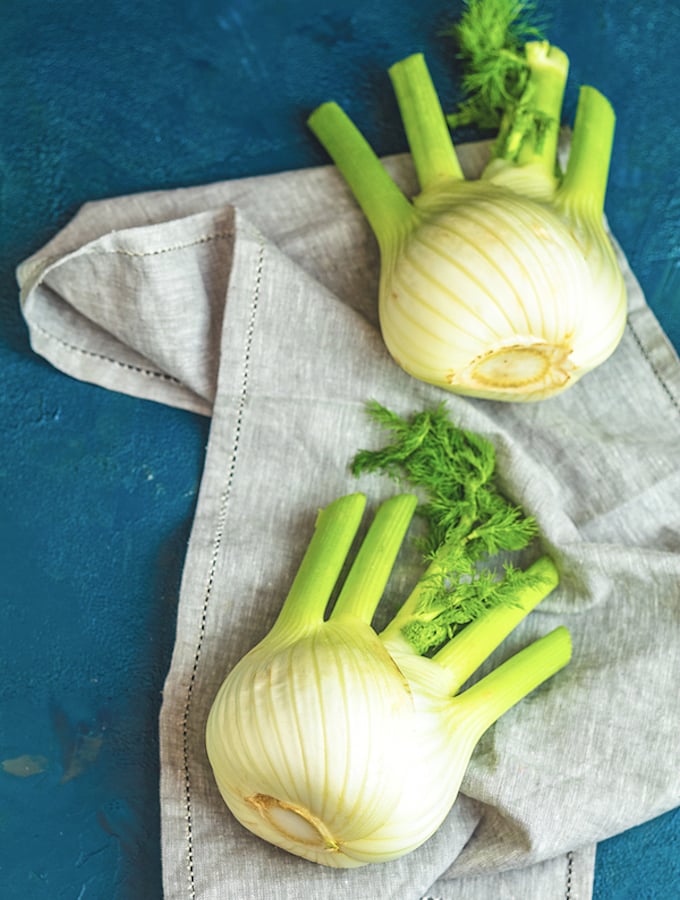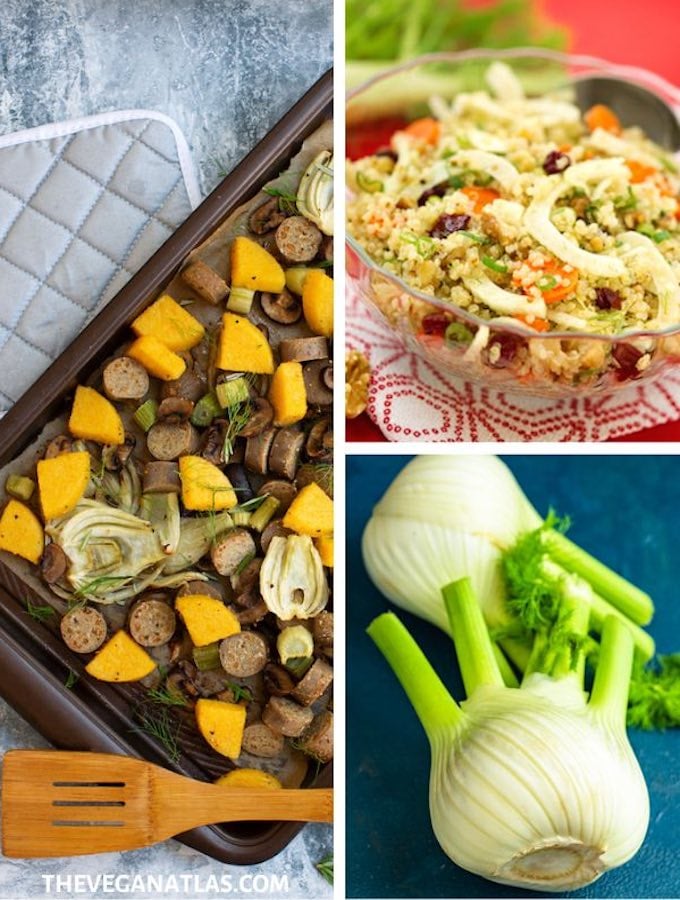In this guide, we’ll give some love to fennel, a unique vegetable with an anise flavor and celery-like texture. Here’s how to use fennel, with tips on buying, prepping, and with ideas and recipes.

Because it has its feathery, dark green tops, it’s sometimes mistaken for dill. Fennel is a green-tinged, almost white bulb with green celery-like stalks sprouting at the top. The stalks are adorned with fernlike, dark green leaves.
Sometimes markets label it as “anise” or “sweet anise,” both are misnomers. It has a gentle, sweet flavor reminiscent of anise or licorice.
Can fennel be eaten raw? Yes! The bulb part, eaten raw, it has a pleasing crunch. It’s available both in mature sizes, with stalks about 14 to 18 inches long, as well as immature “baby” sizes, with stalks about 5 to 8 inches long, less commonly Baby fennel is especially sweet, with an intense anise aroma.
Called finocchio in Italian and fenouil in French, this aromatic vegetable is an essential ingredient in many mouthwatering Mediterranean dishes.
This information is excerpted and adapted from Melissa’s Great Book of Produce: Everything You Need to Know About Fresh Fruits and Vegetables by Cathy Thomas ©2006, reprinted by permission of Melissa’s Produce. For those who love to cook with fennel, or want to use it more often, there’s more to learn than you imagine!

Explore this roundup of plant-based fennel recipes
Buying and storing fennel
Generally, this vegetable’s true season is fall and winter. Choose bulbs that are unblemished, without yellowing or browning; should be fragrant, firm, and rounded. Green feathery leaves at top should be bright green and not wilted.
Refrigerate, unwashed and dry, wrapped in plastic bag up to 5 days. Baby fennel is more difficult to find; sometimes available in markets with large specialty produce items, or farm markets.

How to prep fennel
Wash with cold water. Cut off fern-like greenery at top (reserve it for garnish or last-minute flavor enhancer). Trim away the base, removing and discarding any discolored layers.
To prep the bulb: Cut away the celery-like stalks away where they meet the bulb. To cut into crosswise strips, cut bulb in half lengthwise; place cut side down and cut in half lengthwise again (if there is a core in center, generally it is small and doesn’t need to be removed, but if it’s large, cut it out and remove it with a small paring knife). Cut into crosswise slices. Or for braising, cut the bulb into halves or quarters.
What about the celery-like stalks? Truth be told, they’re quite tough — definitely not for eating raw. You can chop them up and use in homemade vegetable broths; or steam them, then puree in a high-speed blender to add an unusual flavor to soup bases.
Can the feathery leaves be used? Absolutely. Use just as you would fresh dill, which these leaves strongly resemble (though they don’t have a similar flavor) — toss into soups and salads, and use as a garnish for just about anything.

Nutrition information
Fennel is very low in calories, has almost no fat, and is a modest source of fiber. It’s a good source of vitamin C and folate, and has an array of minerals. Apart from the major nutrients, it’sis also a source of antioxidants and phytonutrients. See the full nutritional profile of fennel.

Quinoa and Fennel Salad with Walnuts and Cranberries
How to use fennel
An Italian favorite with pasta: In Italian cuisine, the chopped bulb is used in pasta sauces or steamed and tossed with fresh herbs and a basic vinaigrette. Try this luscious Fennel Pasta.
A celery substitute: Swap it in for celery wherever the latter is called for in raw or lightly cooked preparations.
Gratin: It’s a wonderful vegetable to use in savory gratins like Caramelized Leek, Fennel, & Onion Gratin.
Sautéed or braised: For a basic preparation, cut the bulb into chunks or strips. Sauté in a little olive oil over medium-high heat until golden and touched with light brown spots here and there. Stir often. If you’d like to continue the cooking process by braising, add 1/2 cup vegetable broth per bulb and cook for 10 minutes or so, until tender. Either way, season with salt and pepper.

Soups and stews: Cooked and puréed, this unique veggie makes a delicious creamed soup. Here’s a simple vegan Creamed Fennel Soup. Other ideas to explore are Roasted Fennel and Potato Soup and Fennel and Chickpea Stew Provençal.
Roasted: Add thick slices to your roasted vegetable mélanges —it’s a lovely addition to mixtures featuring root vegetables. Or enjoy it on its own — see these simple recipes for Roasted Fennel with Garlic and Herbs and Roasted Fennel with Potatoes and Peppers.
Pickled: Bite-sized sections can be pickled just as you would any other kind of pickle. Use your favorite pickle recipe, swapping it in for cucumbers, let’s say, or try this Quick Pickled Fennel.
Grilled: Brush 1/2-inch-thick slices of the bulb with enough olive oil to very lightly coat. Cook on both sides on a medium-hot grill or grill pan, until tender-crisp and showing nice grill marks. If desired, toss with vinaigrette. Season with salt and pepper. Can be eaten hot or cold.

Salads of all kinds: Add the thinly sliced bulb (cut about 2 inches in length) to any kind of green salad. Citrus is a perfect companion, as seen in the recipe just above, Jícama and Fennel Salad with Oranges and Herbs. Another delicious dish is Roasted Beet and Fennel Salad with Beet Greens and Oranges.
See more Good Food Guides on this site.

Leave a Reply